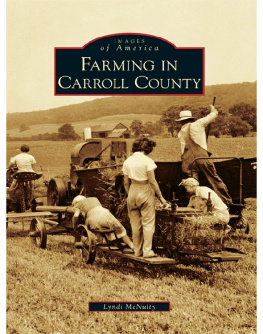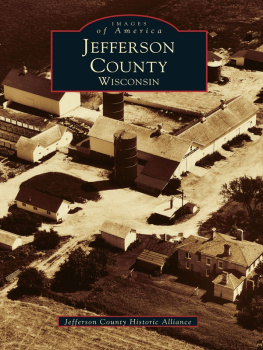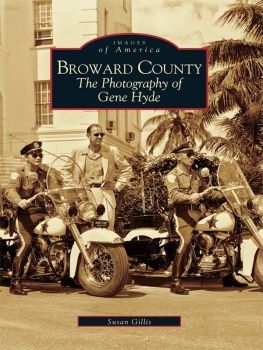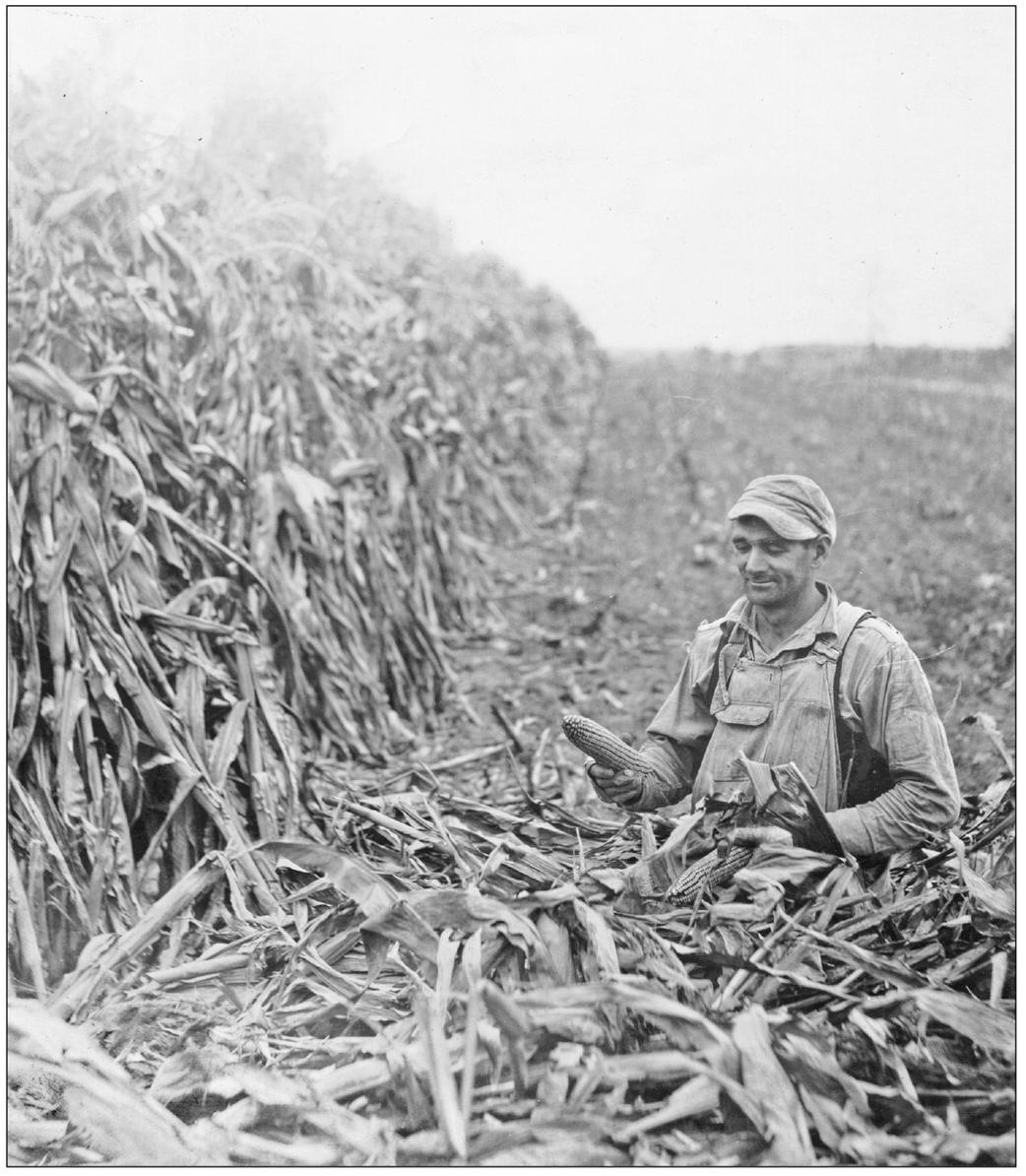
Hubert Jacob Null of Taneytown is husking corn in the late 1940s. According to the U.S. Census in 1950, the county agents report noted that there were 2,766 farms, averaging 91.3 acres, with a value of produce of $4,134 per farm. Carroll County led the 23 counties in Maryland in the production of corn, barley, peas, mature chickens, and eggs. Ninety-three percent of the farms had electricity. (Courtesy of the Null family.)
ON THE COVER: These farmers are baling hay on the Hoke farm in Bachman Valley. The tractor driver is Grace Hoke, and from left to right are Fannie Mae Hoke, Ethel Ward (standing), Florence Hoke Wolfe, and S. L. Hoke Sr. in 1942. (Courtesy of the University of Maryland Extension Service, Carroll County.)
Farming in Carroll County
Lyndi McNulty
Copyright 2009 by Lyndi McNulty
9781439622902
Published by Arcadia Publishing
Charleston SC, Chicago IL, Portsmouth NH, San Francisco CA
Printed in the United States of America
Library of Congress Control Number: 2008937256
For all general information contact Arcadia Publishing at:
Telephone 843-853-2070
Fax 843-853-0044
E-mail sales@arcadiapublishing.com
For customer service and orders:
Toll-Free 1-888-313-2665
Visit us on the Internet at www.arcadiapublishing.com
In memory of Betty Stevenson McNulty.
Table of Contents
ACKNOWLEDGMENTS
A country drive through Carroll County today will reward one with views of landscapes filled with pristine farms, cows leisurely grazing in the field, and fields of corn as far as the eye can see. A stop for homemade ice cream is a must.
My family has been here since the early 1700s. My great-grandfather owned seven farms in the county, and my grandfather grew up on a farm just on the outskirts of Westminster. Attending farm auctions with my mother, Betty Stevenson McNulty, when I grew up, I found a love of old farm implements that led me to become a farm museum curator and design farm exhibits for Carroll County, Baltimore County, and Frederick County Museums.
This book began as a history of farming in Carroll County, but after visiting farm families throughout the county, convincing them to pull their old photographs from albums, walls, and attics, the book became about them. This book is a tribute to the farm families of Carroll County. Royalties from this book will be donated to the historical societies of Carroll County and local farm-related groups.
A special thank-you goes to James C. Voter, U.S. Navy (Retired), who spent hundreds of hours with me researching, interviewing farm families, compiling 2,600 photographs, and supplying technical support. Voter spent 24 years in the U.S. Navy and during his career was captain of the USS Von Steuben submarine. His family roots are in Maine, where he worked in the summers on Voter Hill farm. The farm was passed down through five generations to his great-uncle. In high school, he worked on the Kuerner farm, of Andrew Wyeth fame, that was the property next to his home in Chadds Ford, Pennsylvania. Today he is a resident of Carroll County.
Others who must be thanked include Cathy Baty (curator of the Historical Society of Carroll County), Brian Butler (University of Maryland Cooperative Extension, Carroll County), Nancy Eyler (Taneytown History Museum), Kari Greenwalt and Erroll Smith (director and curator of the Sykesville Gatehouse Museum, respectively), Mike Eacho (Historical Society of Mount Airy), Bryce Workman (New Windsor Heritage Committee), Julia Berwager (Manchester Historical Center), and the farm families of Carroll County.
INTRODUCTION
Roadside farm stands in August boast large, ripe tomatoes, squash, and cucumbers grown on local farms. Here and there, a produce stand is just a table with a cardboard box for money, a traditional honor system in Carroll County for purchasing extra vegetables from small local farms. Traditions live on in Carroll County, where often things are still done the old way, as neighbors stop by Grace Weants farm in Harney to leave their money on her porch for her brown eggs, recycling their egg boxes.
Carroll County boasts many achievements in farming history. One of the most important was the invention of the first self-raking reaper by Jacob R. Thomas in Union Bridge, demonstrated in 1811.
Carroll County was the home of the first complete county Rural Free Delivery Service in the United States in 1899.
R. Wyndham Walden moved to Middleburg in 1872 and established one of the top Thoroughbred horse farms in the late 19th century in America at Bowlingbrook. Horses he bred and trained won more than 1,000 races. Walden was inducted into the National Racing Hall of Fame.
Carroll County produced the world supply of wormseed oil, used as a hookworm remedy and wood preservative.
After World War II, the farm of W. Roger and Olive V. Roop on Middleburg Road in Union Bridge was the gathering place for the international Heifer Project.
In the early days, farms in Carroll County were sustenance farms. Farmers were able to raise enough to feed their families and, sometimes, a little money for needed supplies. Working long hours in snow and rain, and with sheer determination, they raised crops and farm animals. With technological advances, improved farm practices, the use of fertilizers and insecticides, and the construction of local canning factories, the farm business grew and prospered. Farmers had successes working in co-ops and organizations with other farmers. As a result, Carroll County farms supplied milk, produce, beef, and eggs to nearby cities.
In 1941, the county agent reported that Carroll County ranked first in the state in eggs produced, first in the number of chickens, first in the production of corn, and third in the amount of milk produced. Eighty-five percent of the wealth in the county was in agriculture, and 93 percent of the land was in farms.
This book illustrates, with photographs and personal stories, the journey of Carroll County farm families throughout the last century. These families loved farming, its hard work, and its triumphs. As you peruse the photographs in this book, you will see firsthand the faces of the farmers who contributed to Carrolls farming heritage.

This is a copy of the hand-drawn map that the county extension agent used to illustrate his annual report starting in 1932. (Courtesy of the University of Maryland Cooperative Extension, Carroll County.)
One
THE FAMILY FARM
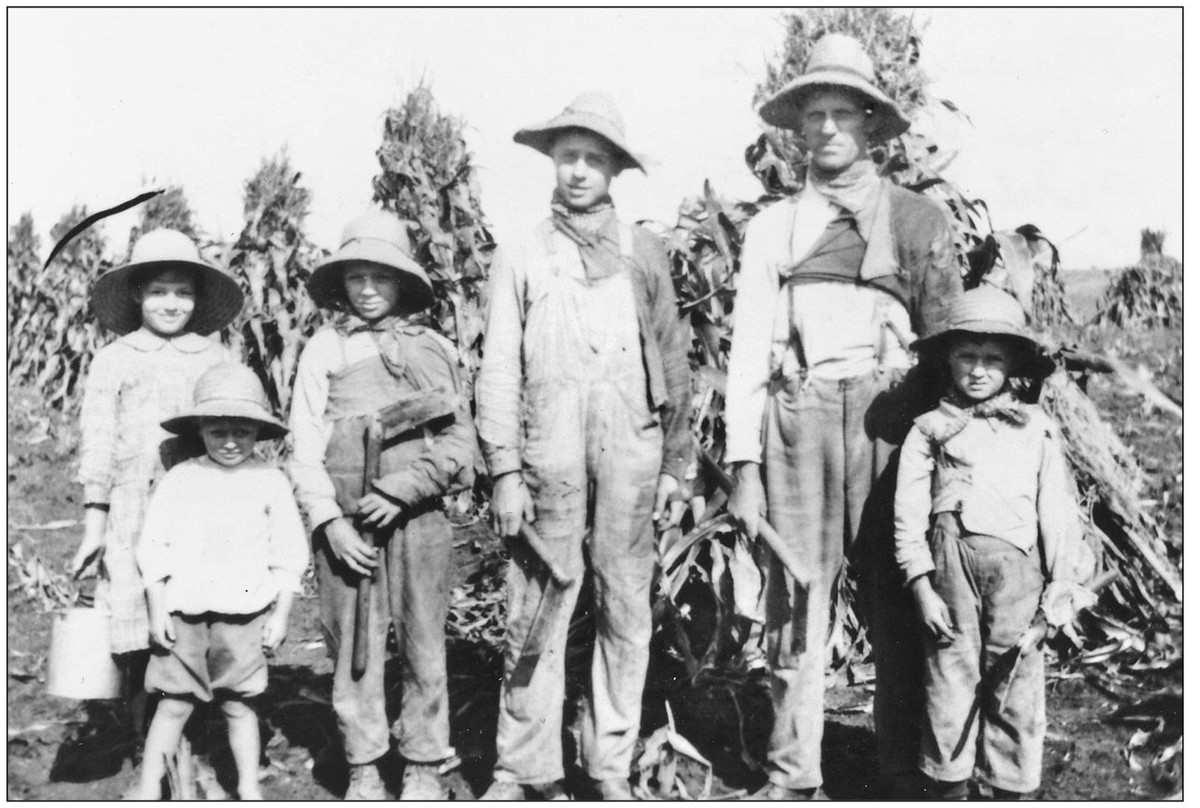
In 1918, on Thanksgiving Day, when the children were home from school, the Wilhide family of Keysville harvested corn. An old pants leg, slipped over their shoulders, protected their clothing from the sharp stalks and kept dirt from going down their necks. They held 20 pounds of stalks in their left arm while cutting it with a corn chopper with their other hand. Big hats kept the corn from cutting their faces. Their mother, May Wilhide, brought their fried chicken dinner to the field. Pictured, from left to right, are children Louise, Clyde, Mehrle, Lloyd, and Maurice with their father, Carroll Wilhide (second from right). (Courtesy of the Wilhide family.)

Men are raising Peter Wilhides barn in Keysville around 1925. It was common for neighbors and relatives to help raise the barn. Farm women had special recipes to feed so many people. (Courtesy of Mildred Stine.)
Next page
